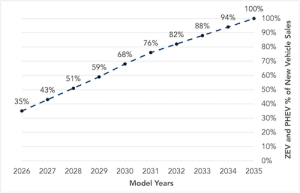Overview: California Emission Regulations – A Revolutionary and Challenging Journey

Balancing the vision of an environmentally friendly transportation sector with the realities of economic and infrastructural constraints is crucial.
As a powerful force in environmental regulations, California’s emission regulations have garnered both admiration and critique. These trend-setting policies have provoked a potential ripple effect, hinting at other states adopting similar vehicle emissions standards. Yet, the regulations present a double-edged sword, bearing significant potential impacts on consumer prices and infrastructural demands.
A Historical Perspective: California’s Impact on Emission Regulations
The California Air Resources Board (CARB) has long been a driving force for environmental policies, paving the way for the implementation of stringent emission standards.
Historically, the California Air Resources Board (CARB) has been an innovator in environmental policies, often establishing more demanding vehicle emissions standards compared to federal regulations, thanks to the authority vested by the Clean Air Act of 1967. While this unique position granted to California has sparked both applause and criticism, it’s undeniable that the state’s strict emission standards have been a significant environmental catalyst.
Probing the ACT and ACCII Programs: Pioneering Green Initiatives or a Potential Fiscal Nightmare?
CARB’s groundbreaking Advanced Clean Trucks (ACT) rules and the broader Advanced Clean Cars II (ACCII) program require that by 2035, a majority of new vehicles sold in the state must be zero emission vehicles. Although this transition symbolizes a massive leap towards sustainability, it comes at an enormous price. Implementing the ACCII rule alone is estimated to cost a staggering $289 billion through 2040.
Enjoying our insights?
Subscribe to our newsletter to keep up with the latest industry trends and developments.
Stay InformedDecoding the Impacts: Unpacking the Economic Consequences of Zero Emission Vehicles

California’s emission rules have recently come under the spotlight… stipulate that by 2035, 75 percent of new Class 4–8 trucks must be zero-emission vehicles.
The high costs of rolling out the ACCII rule will undoubtedly affect consumers, potentially leading to costlier vehicles and additional financial pressure on those who rely on these vehicles for their livelihood. Furthermore, the required expansion of charging infrastructure to accommodate the influx of electric vehicles presents a formidable challenge, particularly in rural areas and on long-haul routes.
Tracing the Domino Effect: The Realities of Other States Following Suit
Despite the considerable challenges, some predict other states may mirror California‘s emission standards, as permitted by the Clean Air Act. However, this projection doesn’t consider the distinct socio-economic and geographical contexts of different states. What works for California might not be practical or feasible for others.
Industry Insights: The Optimistic Voices of Hyliion and Lion Electric
During recent earnings calls, industry leaders from Hyliion and Lion Electric voiced support for California’s ACT rules, advocating that many states will follow California’s lead in environmental policies. But, such sentiment might be overly positive given the potential hurdles and costs involved.
Sustainability Vision Vs Reality: The Complex Road Ahead

Balancing the vision of an environmentally friendly transportation sector with the realities of economic and infrastructural constraints is crucial.
While the shift towards zero emission vehicles is necessary for a sustainable future, it’s riddled with challenges. This complexity intensifies as more states consider adopting similar regulations. Striking a balance between the vision of an environmentally friendly transportation sector and the realities of economic and infrastructural limitations is crucial.
Conclusion: The Intricate Path Forward for California’s Emission Regulations
California’s emission regulations persistently push the boundaries of environmental policies, setting ambitious benchmarks for other states to consider. But these regulations, although noble in intent, could also introduce substantial challenges, spanning from economic impacts to infrastructural demands. As we wrestle with the intricacies of climate change, these initiatives underscore the need for multifaceted, adaptable solutions that respect local contexts and limitations.
Key Takeaways: The Complex Landscape of California’s Emission Regulations
- Historical Leader in Emission Regulations: The California Air Resources Board (CARB) has been a leader in environmental policies since the Clean Air Act of 1967. This legislation allowed California, due to its pre-existing emissions standards, to request waivers for “compelling and extraordinary conditions,” and subsequently set its own more stringent emission standards.
- Advanced Clean Trucks (ACT) Rules: Under California’s Advanced Clean Trucks rules, 75% of new Class 4–8 trucks sold in the state must be zero-emission vehicles (ZEVs) by 2035. This is part of the larger Advanced Clean Cars II (ACCII) program, which aims to transform the vehicle industry in the state towards sustainability.
- Zero Emission Vehicles (ZEVs) Mandate: California’s ACCII program also mandates that 100% of new light- and medium-duty vehicles sold in the state must be zero-emission vehicles by 2035. This is a major step towards reducing greenhouse gas emissions and tackling climate change.
- Costs and Benefits: Implementing the ACCII rule is expected to cost approximately $289 billion through the model year (MY) 2040. However, the California Air Resources Board (CARB) projects that the benefits, estimated at $383 billion, will more than offset these costs. The majority of these benefits come from savings on gasoline and reductions in carbon emissions.
- Influence Beyond California: Given the Clean Air Act’s provision allowing states to adopt California’s emission standards, other states may follow California’s lead. Currently, 17 other states and the District of Columbia have adopted California’s regulations, making up about 40% of new vehicle sales in the U.S. Moreover, a consortium of at least 16 other states, D.C., and Québec are committed to achieving 100% ZEVs by 2050.
- Industry Leaders’ View: Executives from industry leaders like Hyliion and Lion Electric predict that many states will follow California’s lead in adopting stringent emission regulations. This highlights the significant influence California has on shaping environmental policies in North America and beyond.
- Sustainable Future Vision: California’s emission regulations represent a significant step towards a more sustainable future. The move towards ZEVs, endorsed by industry leaders, indicates a growing momentum towards cleaner, more sustainable transportation. With more states likely to adopt similar regulations, the vision of an environmentally friendly transportation sector becomes increasingly achievable.
Dig Deeper into Related Topics
- For a deep dive into the latest DNV Transportation emission report and a perspective on the alarming rise in global CO2 emissions, explore this article.
- Get to know the new FMCSA head, Earl Adams Jr., and discover his promising approach towards trucking regulations, here.
- Learn more about the top 5 breakthroughs in Cummins zero-emission solutions and their significant role in decarbonization for fleets, by visiting this article.
- Explore how regulations impact the transport industry with visit this link.
- Stay informed about the latest updates on vehicle emissions standards by clicking here.
- To understand more about ESG along with environmental initiatives and responsibilities, explore this page.
- Stay abreast of the latest trends in sustainability and its progress, follow this link.
Explore External Resources and Insights
- California Air Resources Board (CARB): Learn more about their mission, history, and the areas they cover.
- Clean Air Act: Understand the regulations and laws in the specific field.
- Hyliion: Find information on their services, history, and commitment to innovation.
- Lion Electric: Learn more about their mission, history, and the areas they cover.
- Advanced Clean Trucks (ACT) Rules: Delve into the specifics of these rules, their historical context, and the areas they influence.
- Advanced Clean Cars II (ACCII) Program: Discover details of this program, its history, and its commitment to accelerating the transition to zero-emission vehicles.




















